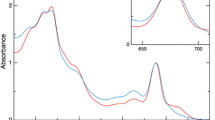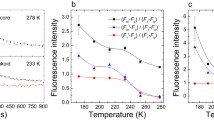Abstract
The relationship between charge recombination at Photosystem II (PS II), as indicated by millisecond luminescence, and PS II quantum yield was studied in spinach thylakoids during electron flow to methylviologen. Under the low magnesium conditions used, a decrease in quantum yield was observed in the absence of non-photochemical excitation quenching, and therefore cannot be due to a restriction in excitation delivery to the reaction centre. It was found that the decrease of the parameter Φp, which is a measure of the intrinsic quantum yield of ‘open’ PS II centers, correlates with an increase in luminescence per ‘open’ center. The relationship between these two parameters was the same whether Φp was manipulated by dissipation of the transthylakoid pH gradient or of the electrical potential. This indicates that the mechanism by which Φp decreases depends in the same way on the two components of the protonmotive force as does the charge recombination at PS II. Calculation of the yield of luminescence with respect to the back reaction will be necessary to determine whether the charge recombination occurs at a sufficiently high rate to be directly responsible for the Φp decrease.
Similar content being viewed by others
Abbreviations
- Fo :
-
dark level chlorophyll fluorescence yield
- Fm :
-
maximum chlorophyll fluorescence vield
- Fv :
-
variable chlorophyll fluorescence yield (Fm-Fp)
- P680:
-
reaction centre chlorophyll of PS II
- PS II:
-
Photosystem II
- qN :
-
coefficient of non-photochemical fluorescence quenching
- qP :
-
coefficient of photochemical fluorescence quenching
- Φs :
-
rate of O2 evolution/incident light
- Φp−Φp/qp; QA :
-
primary stable electron acceptor of PS II
References
Asada K, Neubauer C, Heber U and Schreiber U (1990) Methyl viologen-dependent cyclic electron transport in spinach chloroplasts in the absence of oxygen. Plant Cell Physiol 31: 557–564
Barber J and Kraan GPB (1970) Salt-induced light emission from chloroplasts. Biochim Biophys Acta 197: 49–59
Bjorkman O and Demmig B (1987) Photon yield of O2 evolution and chlorophyll fluorescence characteristics at 77K among vascular plants of diverse origin. Planta 170: 489–504
Bradbury M and Baker NR (1981) Analysis of the slow phases of the in vivo chlorophyll fluorescence induction curve. Changes in the redox state of Photosystem II electron acceptors and fluorescence emission from Photosystem I and II. Biochim Biophys Acta 63: 542–551
Butler WL and Kitajima M (1975) Fluorescence quenching in PS 2 of chloroplasts. Biochim Biophys Acta 376: 116–125
Delosme R (1967) Etude de l'induction de fluorescence des algues vertes et des chloroplasts au début d'une illumination intense. Biochim Biophys Acta 143: 108–128
Demmig-Adams B (1990) Carotenoids and photoprotection in plants: A role for the xanthophyll zeaxanthin. Biochim Biophys Acta 1020: 1–24
Genty B, Briantais JM and Baker NR (1989) The relationship between the quantum yield of photosynthetic electron transport and quenching of chlorophyll fluorescence. Biochim Biophys Acta 990: 87–92
Horton P and Hague A (1988) Studies on the induction of chlorophyll fluorescence in barley protoplasts. IV. Resolution of non-photosynthetic quenching. Biochim Biophys Acta 932: 107–115
Horton P, Oxborough K, Rees D and Scholes JD (1988) Regulation of the photochemical efficiency of Photosystem 2: Consequences for the light response of field photosynthesis. Plant Physiol Biochem 26: 453–460
Horton P, Ruban AV, Rees D, Pascal AA, Noctor GD and Young AJ (1991) Control of the light-harvesting function of chloroplast membranes by aggregation of the LHC II chlorophyll protein complex. FEBS Lett 292: 1–2
Jensen RH and Bassham JA (1966) Photosynthesis by isolated chloroplasts. Proc Natl Acad Sci USA 56: 1095–1101
Jursinic PA (1986) Delayed fluorescence: Current concepts and status. In: Govindjee, Amesz J and Fork DC (eds) Light Emission by Plants and Bacteria, pp 291–328. Academic Press, Orlando
Lavorel J (1975) Luminescence. In: Govindjee(ed) Bioenergetics of Photosynthesis, pp 223–317. Academic Press, New York
Malkin S (1977) Delayed luminescence. In: Barber J (ed) Primary Processes of Photosynthesis, pp 349–432. Elsevier, Amsterdam
Mayne BC and Clayton RK (1966) Luminescence of chlorophyll in spinach chloroplasts induced by acid-base transition. Proc Natl Acad Sci USA 55: 494–497
Neubauer C and Schreiber U (1987) The polyphasic rise of chlorophyll fluorescence upon onset of strong continuous illumination: I. Saturation characteristics and partial control by the Photosystem II acceptor side. Z Naturforsch 42c: 1246–1254
Ogren E and Baker NR (1985) Evaluation of a technique for the measurement of chlorophyll fluorescence from leaves exposed to continuous white light. Plant Cell Environ 8: 539–547
Oxborough K and Horton P (1988) A study of the regulation and function of energy-dependent quenching in pea chloroplasts. Biochim Biophys Acta 548: 128–138
Peterson RB, Sivak MN and Walker DA (1988) Relationship between steady-state fluorescence yield and photosynthetic efficiency in spinach leaf tissue. Plant Physiol 88: 158–163
Quick P and Horton P (1984) Studies on the induction of chlorophyll fluorescence in barley protoplasts. II. Resolution of fluorescence quenching by redox state and the transthylakoid pH gradient. Proc R Soc Lond B 220: 371–382
Rees D and Horton P (1990) The mechanism of changes in Photosystem 2 efficiency in spinach thylakoids. Biochim Biophys Acta 1016: 219–227
Rees D, Noctor GD and Horton P (1990) The effect of high-energy-state excitation quenching on maximum and dark level chlorophyll fluorescence yield. Photosynth Res 25: 199–212
Ruban AV, Rees D, Noctor GD, Young A and Horton P (1991) Long wavelength chlorophyll species are associated with amplification of high-energy-state excitation quenching in higher plants. Biochim Biophys Acta 1059: 335–360
Schreiber U (1986) Detection of rapid induction kinetics with a new type of high-frequency modulated chlorophyll fluoremeter. Photosynth Res 9: 261–272
Schreiber U and Neubauer C (1987) The polyphasic rise of chlorophyll fluorescence upon onset of strong continuous illumination: II. Partial control by the Photosystem II donor side and possible ways of interpretation. Z Naturforsch 42c: 1255–1264
Schreiber U and Neubauer C (1989) Correlation between dissipative fluorescence quenching at Photosystem II and 50 μs recombination luminescence. FEBS Lett 258: 339–342
Schreiber U and Neubauer C (1990) O2-dependent electron flow, membrane energization and the mechanism of non-photochemical quenching of chlorophyll fluorescence. Photosynth Res 25: 279–293
Schreiber U and Rienits KG (1987) ATP-induced photochemical quenching of variable chlorophyll fluorescence. FEBS Lett 211: 99–104
Schreiber U, Schiwa U and Bilger W (1986) Continuous recording of photochemical and non-photochemical chlorophyll fluorescence quenching with a new type of modulation fluorometer. Photosynth Res 10: 51–62
Schreiber U and Schliwa U (1987) A solid-state portable instrument for measurement of chlorophyll luminescence induction in plants. Photosynthe Res 11: 173–182
Sharkey TD, Berry JA and Sage RF (1988) Regulation of photosynthetic electron-transport inPhaseolus vulgaris L, as determined by room-temperature chlorophylla fluorescence. Planta 176: 415–424
Weis E and Berry J (1987) Quantum efficiency of Photosystem II in relation to energy dependent quenching of chlorophyll fluorescence. Biochim Biophys Acta 894: 198–208
Wraight CA and Croft AR (1971) Delayed fluorescence and the high-energy state of chloroplasts. Eur J Biochem 19: 386–397
Author information
Authors and Affiliations
Rights and permissions
About this article
Cite this article
Rees, D., Horton, P. & Schreiber, U. The relationship between Photosystem II intrinsic quantum yield and millisecond luminescence in thylakoids. Photosynth Res 37, 131–138 (1993). https://doi.org/10.1007/BF02187471
Received:
Accepted:
Issue Date:
DOI: https://doi.org/10.1007/BF02187471




